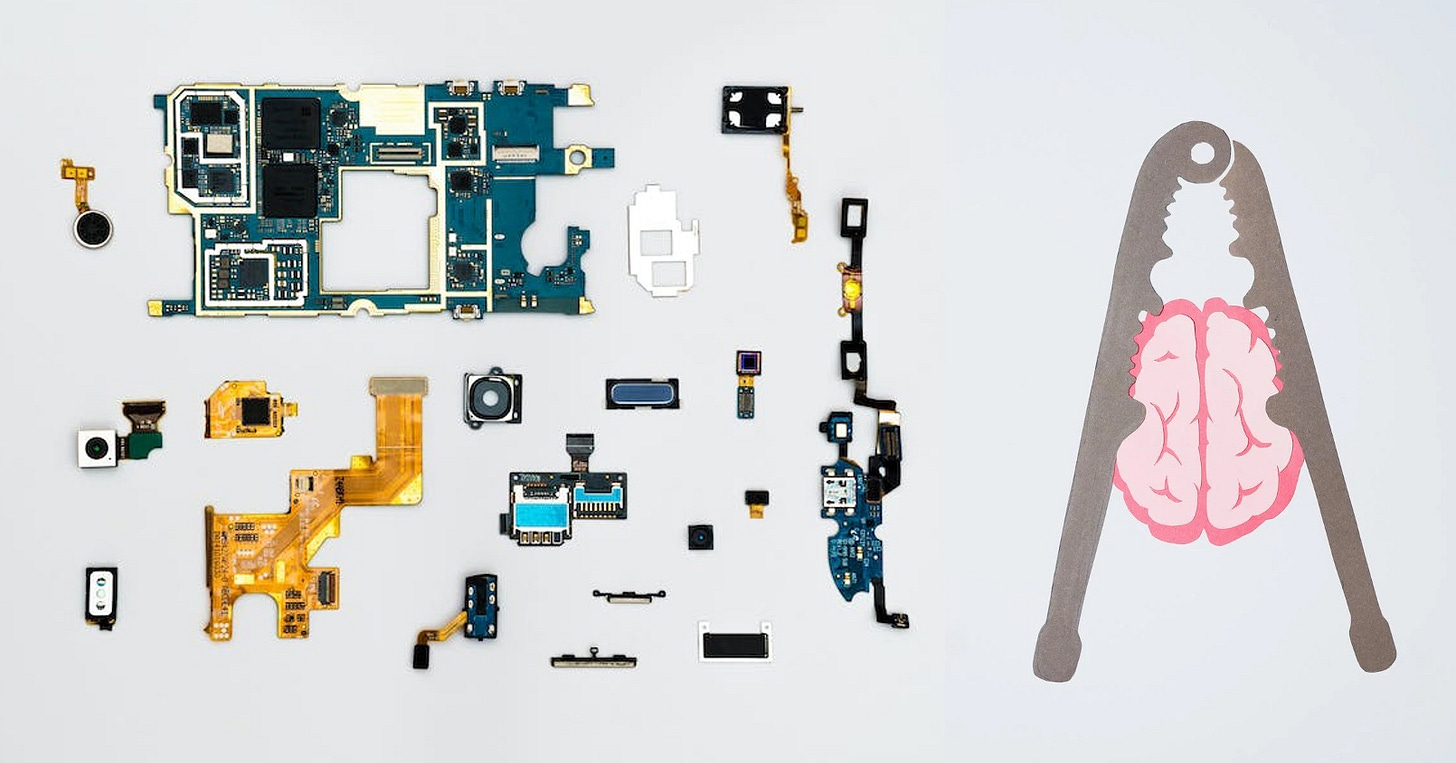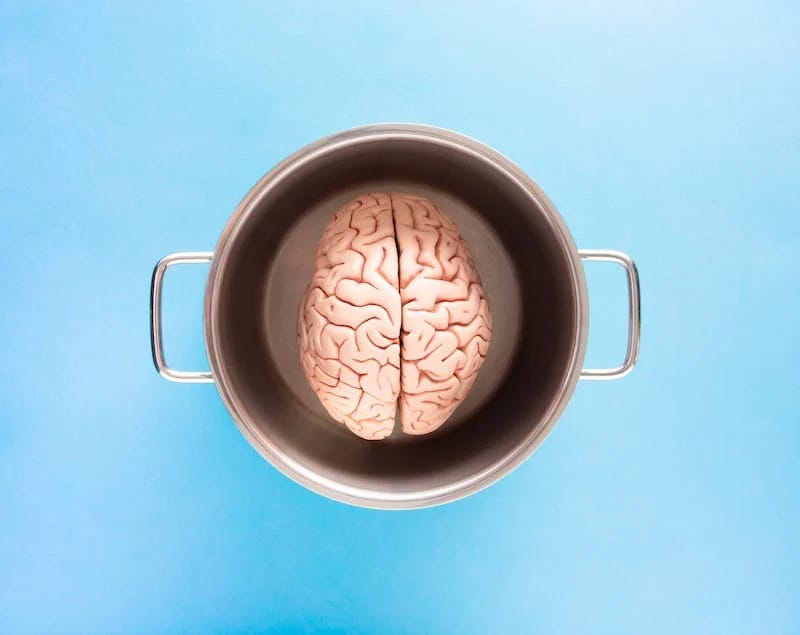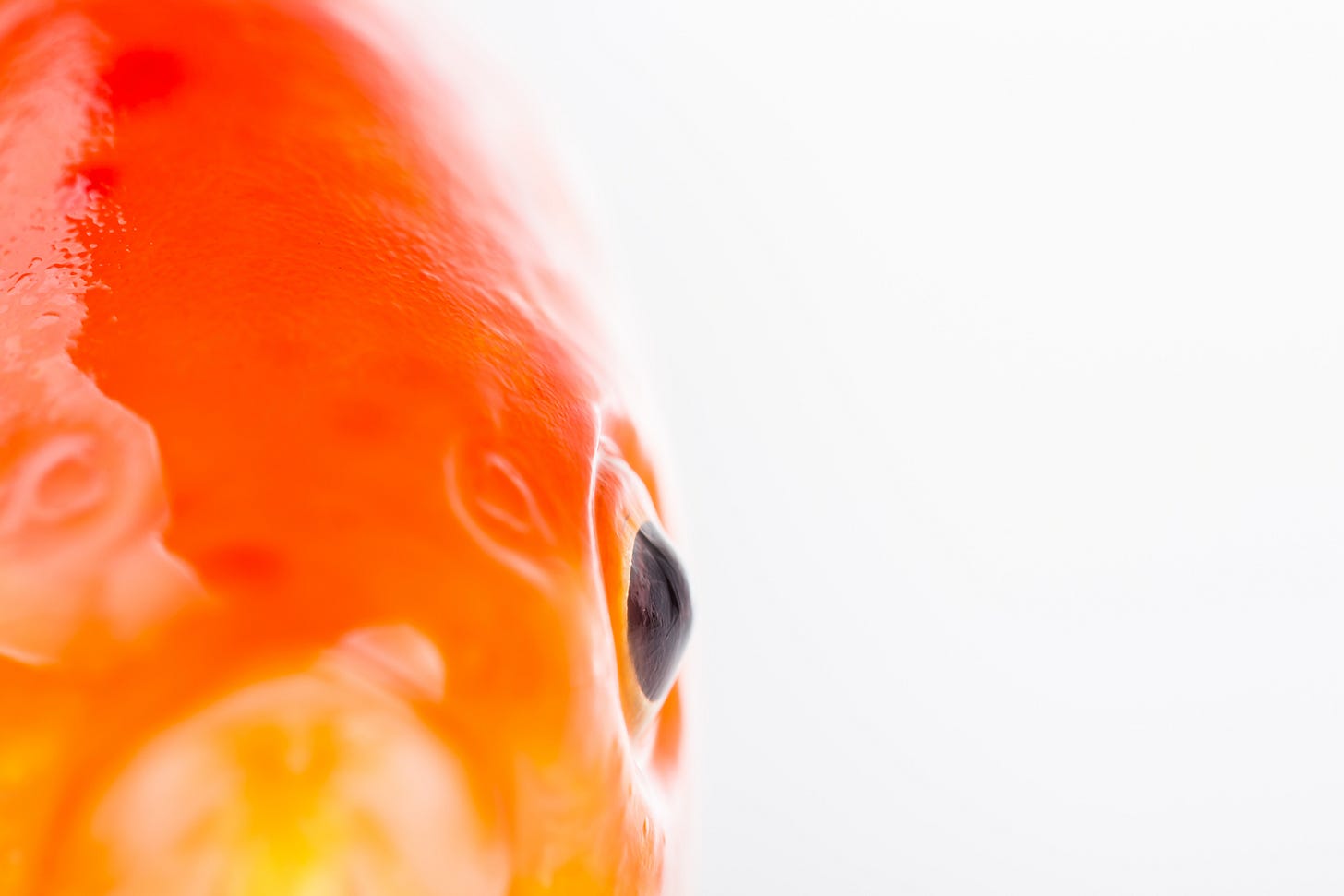From the minds of Sputnik Futures. Exploring every rabbit hole there is. For more wanderings, become an Alice in Futureland subscriber—it's free.
🍄 AudioDose—this is Alice on Sonic Mushrooms: Quantum Tuning here.
🎧 Alice podcasts: Consciousness and the Quantum Mind with Johnjoe McFadden
📘 Alice books: Tuning into Frequency: The invisible force that heals us and the planet
“Over the last decade or so, the rapid rise of AI has lent a new urgency to questions about machine consciousness,” writes neuroscientist Anil Seth in his book, Being You: A New Science of Consciousness [2021] “AI is now all around us, built into our phones, our fridges, and our cars, powered in many cases by neural network algorithms inspired by the architecture of the brain.”
Hello, we’re Alice, and we are always in a state of wander. Big plans afoot for the lab-grown brain—it wants to become conscious. That’s right, before we can even pinpoint where—or even really, how —consciousness “is”, scientists want to build-a-brain and rig robots up with the same stuff that makes us think we’re so special. “What would it take for a machine to become conscious?” asks Seth, who is also Co-Director of the Canadian Institute for Advanced Research (CIFAR) program on Brain, Mind and Consciousness. “What would the implications be? And how, indeed, could we even distinguish a conscious machine from its zombie equivalent?”
Think-y And The Brain
Now if Black Mirror and Blade Runner 2049 were to be believed, we’re on the brink of bringing bioengineered humans to life like Frankenstein’s monster. Fear not though, we’re worlds away from Westworld—it’s just what streaming channels are made of. What we do have however, are brain “organoids”—miniaturized, simplified versions of brain tissue grown in a dish from stem cells, developed to better grasp what’s going on in the brain. “Difficult questions will be raised as models of the human brain get closer to replicating its functions,” writes Nita A. Farahany, Professor of Law and Philosophy at Duke University, Durham, North Carolina, alongside 15 colleagues, in a Nature paper titled: “The Ethics of Experimenting with Human Brain Tissue.” For now though, researchers have deployed brain organoids “to investigate neuro-developmental alterations in people with autism spectrum disorders or schizophrenia.”
Welcome to ALICE’s third leap into the quantum mind. We’ve already covered the nitty gritty of quantum physics, and how it governs all the subatomic particles that make up the universe [Enter the Quantum Mind, The Quantum Blueprint]. We know all about ‘quantum entanglement’, the forever-connection of all these particles, and how Albert Einstein called it “spooky action at a distance.” We discovered that phenomena such as this still keeps scientists on their toes, as they attempt to tackle the where’s and why’s of consciousness—and have seen how many ancient texts explained a lot of this, way back when, already.
Brain WiFi
You may recall last time, we went soul-searching with Dr. Johnjoe McFadden, Professor of Molecular Genetics at the University of Surrey. He wrote about an elderly servant, who 2,700 years ago believed he had built a gravestone for his ‘soul’ after death. “This stele might be one of the earliest written records of dualism: the belief that our conscious mind is located in an immaterial soul or spirit, distinct from the matter of the body,” McFadden wrote for Aeon. Contemplating consciousness further, he asks: “Instead of a code encrypted in the wiring of our neurons, could consciousness reside in the brain’s electromagnetic field?” McFadden, in keeping with the modern school of thought, imagines building artificial conscious minds. “How do the atoms and molecules that make up the neurons in our brain manage to generate human awareness and the power of thought?”
Well, It’s Not Rocket Science …
… it’s consciousness science, a typically trickier topic.
“Our brains are amazingly powerful computers, using not just neurons but the connections between the neurons to process and interpret information,” writes Elizabeth Fernandez in Big Think. “And then there is consciousness, neuroscience’s giant question mark. What causes it? How does it arise from a jumbled mass of neurons and synapses? After all, these may be enormously complex, but we are still talking about a wet bag of molecules and electrical impulses.”
“Without EM field interactions,” continues McFadden, “AI will remain forever dumb and non-conscious. Yet the cemi (conscious electromagnetic information) field theory also provides the exciting and potentially world-changing prospect of building artificial conscious minds. It will require a different kind of computer architecture that, like our own brain, computes with fields as well as conventional logic gates that encode only bits. The architecture of our own EM field-sensitive brains provides lots of clues as to how these revolutionary artificial brains of the future could be built. Transforming those clues into a new form of computing could finally deliver the dream of conscious, general intelligence-enabled AI.”
Machines Like Me
AGI is the New AI—but what is it? AI, as we know, is machine-based, pattern recognition—a clever system, but certainly not conscious. Artificial General Intelligence, or AGI, is that ambitious next step. It wants to wake up the wires … give Tin Man a heart. While AI typically focuses on solving specific problems, AGI aims to solve any problem that a human can—with depth of understanding and emotional range. So far, no such system has been demonstrated. Phew!
“The way I see it, consciousness won’t be ‘solved’ in the same way that the human genome was decoded, or the reality of climate change established,” writes Seth in Being You. “Nor will its mysteries suddenly yield to a single eureka-like insight—a pleasant but usually inaccurate myth about how scientific understanding progresses. For me, a science of consciousness should explain how the various properties of consciousness depend on, and relate to, the operations of the neuronal wetware inside our heads. The goal of consciousness science should not be—at least not primarily—to explain why consciousness happens to be part of the universe in the first place. Nor should it be to understand how the brain works in all of its complexity, while sweeping the mystery of consciousness under the carpet.”
Seth says that he uses the word ‘wetware’ to “underline that brains are not computers made of meat. They are chemical machines as much as they are electrical networks. Every brain that has ever existed has been part of a living body, embedded in and interacting with its environment—an environment which in many cases contains other embodied brains. Explaining the properties of consciousness in terms of biophysical mechanisms requires understanding brains—and conscious minds—as embodied and embedded systems.”
Back in 1983, the theory that quantum entanglement is tied up to human consciousness went all the way to the top. A CIA report titled “Gateway Experience,” believed it was possible for our consciousness to alter the universe since reality is a holographic projection—and everything is connected through energy vibrations. The report claimed that an altered state of human consciousness might be able to transcend space and time, and called the universe a “complex system of interacting energy fields.” It asserts that human consciousness is no different, just another vibrational pattern of energy.
Today it’s more down to earth, simply wiring machines up with human consciousness. But first…
How To Build A Brain
It’s an easy recipe, just human stem cells and the perfect conditions needed to create a miniature lab-grown brain, as discovered by researchers back in 2008. According to the stem cell biology journal Cell Stem Cell, these brain “organoids” measure ~4 millimeters in diameter and contain 2 million to 3 million cells specific to one brain region. So brain baked, now what? Researchers can test potential therapies on such miniature version of a patient’s own tissue, which is revolutionary for future biomedical discoveries.
How Do We Get ‘It’ To … Conscious?
We don’t, yet.
“There is a worry that AI–whether conscious or not–is on a runaway path to overtake human intelligence, bootstrapping itself beyond our comprehension and our control,” writes Seth in Being You.
Seth is referring to the ‘Singularity’ hypothesis, popularized by the futurist, inventor and Google director of engineering Ray Kurzweil, which he explores in his seminal books The Age of Spiritual Machines [1999] and The Singularity is Near [2005]. The Singularity reflects the exponential growth over the last few decades in raw computational resources that have brought us, among many things, artificial intelligence.
Seth questions, “Where are we on this exponential curve? The problem with exponential curves—as many of us learned during the recent coronavirus pandemic—is that wherever you stand on them, what’s ahead looks impossibly steep and what’s behind looks irrelevantly flat. The local view gives no clue to where you are.”
Perhaps we are still looking for that clue. A week after the release of OpenAI's large language model GPT-4, the ‘Pause Giant AI Experiments: An Open Letter ‘ was published by the Future of Life Institute, calling for “all AI labs to immediately pause for at least 6 months the training of AI systems more powerful than GPT-4." The letter cited risks such as AI-generated propaganda, extreme automation of jobs, human obsolescence, and a society-wide loss of control. It has received more than 33,000 signatures, including academic AI researchers and industry CEOs—including Elon Musk and Steve Wozniak—but not Kurzweil. He claims it’s impractical, and won’t be adhered to by competitors, and would be costly in many fields where AI is helping, such as medicine and health, education, pursuit of renewable energy sources to replace fossil fuels. Kurzweil believes that the safety concerns raised can be addressed.
“There are our Promethean fears that our creations will turn on us in some way or another–fears which have been recognized, repackaged, and sold back to us by any number of science fiction movies and books,” writes Seth. “Finally, there is the unfortunate fact that the term ‘consciousness’ is often bandied about with an unhelpful sloppiness when it comes to the capabilities of machines. For some people—including some AI researchers—anything that responds to stimulation, that learns something, or that behaves so as to maximise a reward or achieve a goal is conscious. To me this is a nonsensical overextension of what ‘being conscious’ reasonably means. Mix all of these ingredients together and it is hardly surprising that many people think that conscious AI is just around the corner, and that we should be very worried about what happens when it arrives.”
Neural Networks, Electric Souls
Neural Networks (also known as artificial neural networks) are the driving force behind modern AI systems, and they are modeled after the human brain. Human brain organoids contain only two to three million cells, compared to a real brain’s 86 billion neurons and a similar number of non-neuronal cells, so they’re primitive at best. “Given such constraints, the possibility of organoids becoming conscious to some degree, or of acquiring other higher-order properties, such as the ability to feel distress, seems highly remote,” wrote the authors of the Nature paper, in 2018.
But does it? Cell Stem Cell reports that organoids have produced coordinated waves of neural activity (EEG patterns), resembling what’s seen in preterm human babies. This opens up a hypothetical, ethical debate: “If researchers could create brain tissue in the laboratory that might appear to have conscious experiences or subjective phenomenal states, would that tissue deserve any of the protections routinely given to human or animal research subjects?”
McFadden however, remains optimistic on his brain WiFi theory. “It would of course be hugely challenging to reverse-engineer the informational content of a human brain and then to upload it to a more durable silicon-based computing substrate that processed information both along wires and through fields,” he says. “Challenging, but not impossible. They won’t be made of basalt, but it might one day be possible to build potentially immortal receptacles for electric souls.”
It’s Not About AI. It’s About IA.
The convergence of quantum computing, artificial intelligence and human intelligence is the future that we should be preparing for. A child born today will be the first ‘quantum AI natives,’ learning, developing, and working alongside GAI and QAI (Quantum Artificial Intelligence). This generation—and for more to come—will perhaps be developing a new intellectual skill set that encompasses a cultivated consciousness in collaboration with the AI we are just beginning to build. The debate should not be just about AI, but about the IA—‘intelligence amplification.’ As the pace of quantum computing and AI accelerates, we need to come to grips with the new intelligence we are creating. To quote science fiction writer Vernor Vinge—who coined the term ‘singularity’—in the relatively near future “we will see change as great as the rise in humankind within the animal kingdom.” In his interview with ALICE, Vinge shared his belief that it is very likely that in the next ten to twenty years there will be people much smarter than we are, a greater difference than what now exists between a person and a goldfish. Enhancing intelligence, according to Vinge, will at some point lead to a positive feedback loop; more intelligent systems can design even more intelligent systems, and much quicker than the original human designers. This positive feedback will be powerful enough that within a very short time—months, days, or even hours—the world will be transformed beyond recognition and suddenly inhabited by super-intelligent beings.
Goldfish, are you ready for your upgrade? 😊
The Coming Wave
“Three or four years ago people said, AIs will never be creative and, judgement and inventiveness, imagination, creativity will always be the preserve of humans. Then we saw the generative image revolution. Then people said well, empathy and kindness and emotional intelligence are always going to be the preserve of smart humans, machines are never going to be able to imitate that kind of sensitivity and intelligence. It's pretty clear on both of those counts, the models are almost there and will, I think, in the next few years, definitely, unquestionably exceed those capabilities.” Author Mustafa Suleyman argues that while these changes don’t fundamentally change what it means to be human, they do add new categories and classes of things to the world that will take a lot of adjustment. Within five years or so we will essentially be living amongst a new species. "We have to decide what freedoms we want to give them, what kind of wide ranging actions these AIs can take in any particular environment. We will have to decide how we want them to relate emotionally, intellectually, commercially, politically, to the rest of our society. As Suleyman argues in The Coming Wave these will need to be fairly restrictive, we need to keep AI “contained” in the widest possible sense. Given the scale of the change, containment in this sense is not just a luxury; it’s a necessity.
What Else We Are Wondering…
🔍 Entanglement is … Heartfelt?
The beat goes on. Using tweaked MRI machines, scientists at the Institute of Neurosciences at Trinity College Dublin have found a potential case of “entanglement” happening between heart and brain. These experimental indications of ‘non-classical brain functions’ were published in the Journal of Physics Communications last year, by Trinity’s lead physicist, Dr. Christian Kerskens and Dr. David López Pérez of the Polish Academy of Sciences. “I think if you ask, most neuroscientists — or even physicists — they would say that it’s not possible to find entanglement in the brain,” Kerskens told Salon. “[However] when I studied the dynamics of blood flow, I thought something [is] going on there that you can’t really explain with just classical physics.”
🔍 OK (we’re) Computer …
… but we’ve still got the edge. Humans have consciousness—an ability to not just feel but think, remember and imagine. “Computers process lots of information yet have not exhibited the slightest spark of consciousness,” writes McFadden. “Several decades ago, in an essay exploring the phenomenology of consciousness, the philosopher Thomas Nagel asked us to imagine what it’s like to be a bat. This feature of being-like-something, of having a perspective on the world, captures something about what it means to be a truly conscious ‘knower’.” But do we place too much importance on this, in the grand scheme of things? “Because consciousness is so important to humans, we tend to think there is something special about it,” writes Paul M. Stutter, in a Live Science article titled: “Does Consciousness explain quantum mechanics?” Stutter is a Research Professor in Astrophysics at SUNY Stony Brook University. “After all, animals are the only known conscious entities to inhabit the universe.”
🔍 Choose Your Own Reality
In Observer [2023], consciousness, quantum mechanics and biology clash in a new novel written by a scientist and sci-fi author together. Stem-cell researcher Robert Lanza and Nebula and Hugo Award-winning author Nancy Kress’s novel “is about how we understand reality, and nothing could be more important about that, because everything else is based on it,” Kress tells the Fiction Science podcast. It’s described as “a rethink of everything we know about time, space and indeed the universe itself.”
Craving more?
📘 Alice in Futureland books
🎧 Alice in Futureland podcasts
🎧 Consciousness and the Quantum Mind with Johnjoe McFadden
Thanks for tuning in.
For more wanderings, become an Alice in Futureland subscriber—it's free.
Invite your friends to this mad tea party and let's see how many things we can learn before breakfast.
©2023 Alice in Futureland







